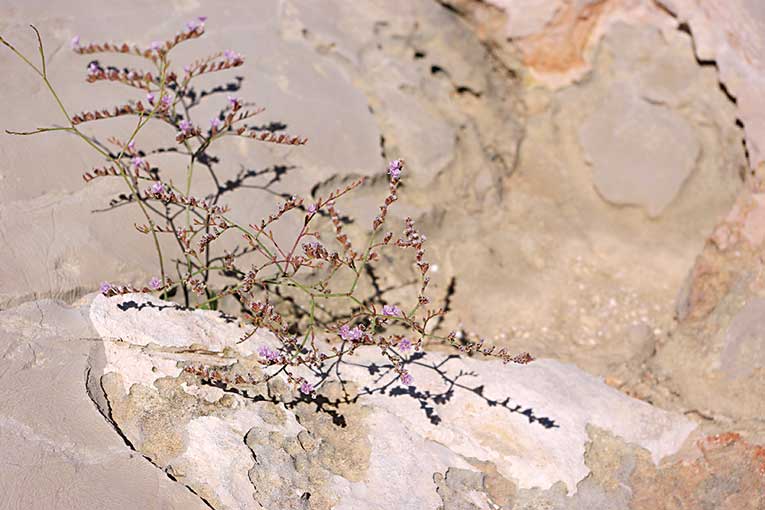
The expected effects of global environmental change over the coming decades may worsen the situation for many currently endangered Valencian plants, even leading to the localised extinction of some species which have no replacement habitats. This paper analyses four cases of affected environments: coastal systems, wetlands, sub-Mediterranean shade forests, and high mountain vegetation.
Keywords: climate change, endangered species, endemic plants, Valencia, extinction.
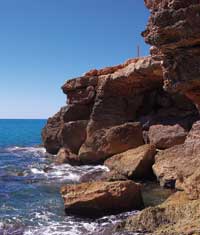
Above, cliff foot containing the La Torre de la Badum (Serra d’Irta, Peniscola) flora micro-reserve, with the only known natural population of Limonium perplexum (header picture). The cliff is at risk due to landslides or complete collapse caused by headward marine erosion. / Emili Laguna
Mediterranean climate areas on our planet are considered to be especially sensitive to the effects of climate change. Although discussion often focuses on climate change (Moreno-Rodríguez, 2005), it is clear that its effects cannot easily be separated from other influences caused by human activity because all of these forces usually synergise. Taking into account the predicted climate change scenarios, plus these synergies, one of the most sensitive areas in Europe may be the Valencia region; some of the most vulnerable natural environments can be found in this territory, where ecosystems have continuously been damaged over decades.
In this paper, we will examine, based on their abundance and representativeness, four large environmental areas that are usually considered to be especially sensitive (Felicísimo, Muñoz, Villalba, & Mateo, 2011): coastal ecosystems, wetlands, sub-Mediterranean shade forests, and high mountain plant communities. The list could be longer, especially if we include the most sensitive microhabitats, but the aforementioned areas are perfect for exemplifying the connection between the effects of climate change and other influences derived from damage to the environment and to the ecosystem cycles, as well as the easily perceptible problems they cause.
Unfortunately there is less information available on non-vascular flora and fungi than on Valencian vascular plants. In recent years, the field has devoted special attention to the latter type of endemic species (Laguna, 2007), particularly the endangered ones (Aguilella, Laguna, & Fos, 2010; Laguna et al., 1998). Certainly, many of the species included in these large groups of vascular plants exemplify the risks and negative effects that the conjunction of environmental change and loss of plant-type resilience – mostly generated by the direct or indirect action of humans (Costa, 1999) – has on these key environmental areas.
The following paragraphs try to summarise the perceivable or expected risks for these four mentioned environments, indicating examples of outstanding species that are particularly endangered at the moment (or will be in the near future), to the point of being virtually extinct. This is because, despite the fact that they are maintained in their germplasm or in ex situ artificial populations, we are facing the complete disappearance of the conditions they need to sustain themselves in situ, in their original ecosystems and locations.
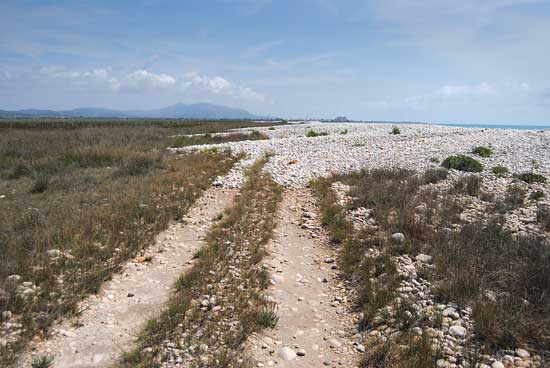
Natural retreat of rock dunes, coming over a path, in Prat de Cabanes-Torreblanca. «Faced with a scenario of low and regressing coasts, this shoreline recession naturally ends up clashing against and gradually eroding a wall of hundreds of kilometres of shore roads» / Emili Laguna
Coastal environments
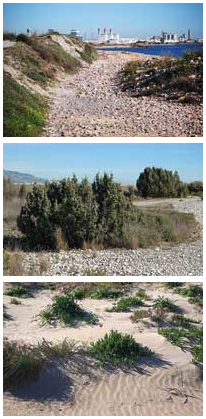
Effects of coastal erosion on the dunes at La Marjal dels Moros (Sagunto), where the increasing force of storms in recent years has added to the effect of the lengthening of the breakwaters at the Sagunto port. The old access path, around 3 metres wide, and the dune platform separating it from the sea – around 30 metres wide – have disappeared in the last few years. In the central photograph, the remaining dune community of Juniperus macrocarpa in Prat de Cabanes-Torreblanca. In the last picture, Carpobrotus edulis invades the new dunes between El Dosser and Cullera. / Emili Laguna
The instability of coastal ecosystems facing large-scale environmental change is evident, not only because global warming is likely to raise sea water levels, affecting sand dunes and flat coastal areas (Moreno-Rodríguez, 2005), but also because of the strong accumulated environmental alterations suffered by the Valencian coastline in the last few decades. These alterations often result in the near-disappearance of certain plant communities, or in storm erosion effects, which are usually worse than expected (Costa, 1999). There are several causes of these changes, like new infrastructure and increased urban concentration on the coastline, the increase of harmful substances in sea spray, the systematic extraction of natural organic deposits from phanerogam seaweed, or modification of the flow or intensity of sea currents near the shore due to the creation of port breakwaters. These represent a collection of only some of the most direct and evident causes, to which we must add the deficiency of large fluvial deposits, currently being sequestered at the bottom of the reservoirs of the largest rivers.
Faced with a scenario of low and regressing coasts, this shoreline recession naturally ends up clashing against and gradually eroding a wall of hundreds of kilometres of shore roads, which have been systematically fostered by current laws in an attempt to ensure public access to the land-sea boundary. Many of these problems have been pointed out by Valencian scientists, even before climate change became the main leitmotiv for the defense of the territory – for example, see the work by Costa (1986, 1999), Costa et al. (1984), and Rosselló (1995). It is well known that such messages are easily forgotten in times of fast economic growth, and the collective reflections that periodically revive them last only a few months or years after big environmental or economic damage events caused, directly or indirectly, by the systematic destruction of the unstable balance between land and sea in coastal ecosystems.
This results in the progressive fragmentation of natural vegetation – or even its complete destruction during storms – and the subsequent genetic risks for the most seriously endangered species, which become increasingly isolated and limited, and therefore, result in inbred populations. The loss of the quantity and quality of sand dunes is well known. There are noteworthy examples such as Juniperus macrocarpa (Costa, 1999), which survives comfortably only in a few protected natural spaces such as Serra Gelada, Prat de Cabanes-Torreblanca, and Devesa de l’Albufera, and which is sometimes fostered by strong conservation efforts with the repopulation and restoration of sand dune habitats (Vizcaíno, Collado, & Benavent, 2000); but it has completely disappeared from other locations, including Canet d’en Berenguer. The number of rare or endangered species in low coastal systems is, indeed, noteworthy, because it affects most structural plants in the same plant communities: Achillea maritima, Euphorbia paralias, Calystegia soldanella, Chamaesyce peplis, etc.
Of the four natural populations of the endemic species, Silene cambessedesii (from Castellón and the Pityuses [the collective name for the Balearic Islands of Ibiza, Formentera, S’Espalmador and other small islets in the Mediterranean Sea ]), known for the last two decades, only one remains, in the flora micro-reserve on the Almenara beach, which, fortunately, has been supplemented – although maybe only temporarily – with new artificial populations (Servei de Vida Silvestre, 2013). In the case of the southern area of the Marjal dels Moros in Sagunto, near Puçol, the sea has recently almost completely destroyed the sand dune and the protection hillock, and it is clear that in a few years, sea water could easily flood the salt marshes. These salt marshes are the classic location for sea lavender (Limonium angustebracteatum), and a good part of the world’s specimens of two of the most seriously endangered Valencian endemic species, Limonium dufourii and the hemiparasite Odontites kaliformis. Offshore, in front of the low coasts, many of the old seaweed populations of Posidonia oceanica have now disappeared, or they have been heavily altered. Both submarine and overwater ecosystems suffer from the progressive spread of invasive exotic species (Caulerpa taxifolia, C. racemosa var. cylindracea, Carpobrotus edulis, C. acinaciformis, Agave americana, etc.), which are often tropical and likely to benefit from global warming (Capdevilla-Argüelles, Zilletti, Suárez, 2011).
The aforementioned pattern is repeated on rocky coasts, with the additional problem, as indicated by Costa (1986, 1999) and Costa et al. (1984), that almost every cliff in coastal mountain ranges in the region is the home for one or two endemic species of the Limonium genus. Much of the prior, or ongoing, damage that may become worse with large-scale environmental change has been mentioned by Aguilella et al. (2010). In Les Rotes, Dénia, where the world’s largest accessible population of the endemic species Limonium rigualii was found, the sea has destroyed most of its specimens. In the opposite corner of the Valencian coast, on Serra d’Irta, a small fragment of cliff hanging over the sea contains, in just over forty square meters, all the world’s native population of Peniscola sea lavender, Limonium perplexum, on terrain that is hugely vulnerable to collapse.
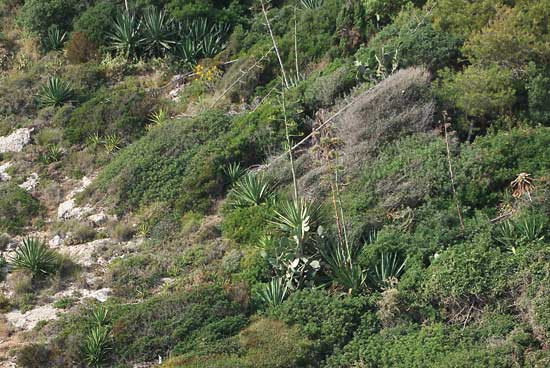
Landscape progressively covered by invasive plants (Agave sisalana, Opuntia ficus-indica, etc.), which are gaining ground in the scrublands near Cullera. «Sea-facing cliffs along the rocky Valencian coasts, often crowned with residential areas, concentrate a significant number of invasive exotic plants» / Emili Laguna
Obviously, sea-facing cliffs along the rocky Valencian coasts, often crowned with residential areas, concentrate a significant number of invasive exotic plants, due to the unwitting improper disposal of pruning waste or the natural expansion of the most aggressive ornamental species. In many cases, the same resident tourists from central and Northern Europe that contributed to the growth in economic wealth on the Valencian coast over the last few decades, also introduced the cultivation of many exotic thermophilic ornamental plants – often cacti and succulent specimens for collections; when these species escape from cultivation, they sometimes establish themselves in the wild on Valencian coasts, the only known location on the European coastline where they can do so (e.g. Cylindropuntia pallida, Euphorbia candelabrum, Pachycereus marginatus, etc.).

Left, water lilies (Nymphaea alba) water lilies (Nymphaea alba) are one of the species that have seen their numbers decrease more significantly in the Valencia region, including the disappearance of great communities of pond plants in Almenara during the 1990s and in Xeresa-Xeraco today. In the central photograph, a view from the Lavajo de Abajo flora microreserve in Sinarcas. In the last picture, Phyllitis sagittata, an extinct species in its two traditional Valencian locations (Benidoleig and Coves de Vinromà), recently re-discovered in old irrigation wells in Vinaròs. / Emili Laguna
Despite being saved in extremis from disappearing due to urban expansion, many populations of the famous Helianthemum caput-felis north-east and south from Alicante have been displaced because of the collapse of their home cliffs and the spread of invasive plants into their habitat (Acacia saligna, Pittosporum tobira, Opuntia ficus-indica, Agave americana, etc.). At the only point of rocky coast in the province of Valencia, the Cullera cliffs, the flora micro-reserve that protects the only remaining population in the world of the plant association Crithmo-Limonietum dufourii seems to be completely surrounded by land dominated by invasive exotic species (Agave sisalana, Senecio angulatus, Freesia refracta, Solanum bonariense, etc.). In all of these cases (Aguilella et al., 2010), the vital area of rare or endangered species, often exclusive and almost extinct, is reduced to a line only a few meters wide, now completely exposed to the pounding of marine erosion.
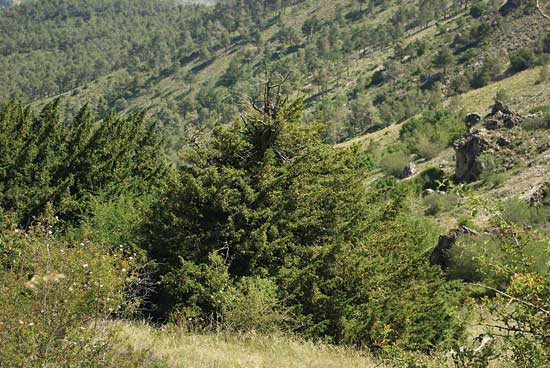
Remains of the old yew woods (Taxus baccata) at the Teixera natural space in Agres. / Emili Laguna
Wetlands
Water-based plant communities are especially sensitive to the expected effects of climate change in the coming decades in which a global reduction in precipitation is expected, or at least a tendency for them to be more concentrated – fewer rainy days but with much heavier rains (Moreno-Rodríguez, 2005). Although agriculture – sometimes blamed for exaggerated water consumption and for the overexploitation of aquifers – has become less important in the Valencian economy in the last few decades, water tables have decreased significantly, negatively affecting wetlands, especially inland. Endorheic basins have also decreased in quality due to pollution, eutrophication, and a growing tendency towards the concentration of invasive species. A direct consequence is the almost complete disappearance of some previously abundant plants, such as Nymphaea alba or Utricularia australis. The only Valencian population of the Althenia orientalis species became extinct last decade, when the pool where it lived in the Aigua Amarga salt marsh dried up (Aguilella et al., 2010).
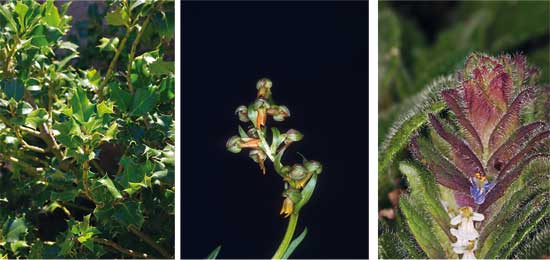
On the left, the common holly (Ilex aquifolium) is, probably, one of the most representative and well-known examples of widely distributed European relict flora sheltered in our high mountain environments. At the centre, Coeloglossum viride, a typical orchid in Euro-Siberian and sub-Alpine pastures that hides at the core of shade forests northwest of Castellón. On the right, Ajuga pyramidalis, one of the most representative shade species, high-mountain relict flora with small populations, represented in the southern Iberian System by the subspecies meonantha. / Emili Laguna
In coastal lakes, the problems can be substantially worse because of the increase in the level of sea water, infiltration, and underground salinization. This causes displacement of species that need regular and prolonged drying of marshes and other saline locations (Moreno-Rodríguez, 2005), and favours the spread of ubiquist plants resistant to flooding, both native (the common reed, for instance, Phragmites australis subsp. chrysanthus) and invasive exotic plants (e.g. giant cane, Arundo donax). The list of endangered species is too long to name them all, but includes exclusively Valencian plants like Thalictrum maritimum or many Limonium species (L. santapolense, L. parvibracteatum, etc.).
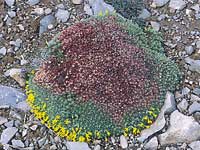
Vitaliana primuliflora subsp. assoana, true representative of high-mountain flora in the Javalambre massif, with only three known specimens in the Valencia region. The effect of climate warming and the loss of global humidity in the ecosystem leads to the gradual death of the shrubs. / Emili Laguna
But maybe we should focus on small, temporary ponds on acid soils, which are very rare in the Valencia region and are true «hotspots» for flora preservation because of their exceptional concentration of rare plants of great scientific interest in just a few square meters. Some examples of locations where almost every species can be considered unique are Los Lavajos de Sinarcas, the Cavall pool in Albalat dels Tarongers, or the Soneja meadow (Laguna et al., 1998). The vegetation is arranged in perfect concentric circles – sometimes only a few centimeters wide – where successive plant macro-communities occupy space and time like a jigsaw puzzle that can be undone with relatively small disruptions in climate regularity. Many of their species are real living fossils of our flora, like the pteridophytes Isoetes velatum and Marsilea strigosa. Other particularly rare plants – such as Littorella uniflora, Elatine brochonii – are among the smallest native plants, which often depend on the preservation of the ground micro-relief.
We must not forget that, apart from wetlands – understood as areas with surface water – water in caves and other underground hollows is also very important in Valencia. In addition, these locations shelter an important collection of endemic and endangered invertebrates (Domingo, Montagud, & Sendra, 2005). Regarding the flora, the loss of the water table and of environmental humidity seems to be the main factor which has contributed to the local extinction of mule’s spleenwort (Phyllitis sagittata) over the last decade, and for the loss of specimens of hart’s-tongue fern (P. scolopendrium); the former has been rediscovered in traditional irrigation wells north of Castellón, instead of in coves and springs, as was the case with the old previously-known communities of these plants in Benidoleig and Coves de Vinromà (Aguilella et al., 2010).
Sub-Mediterranean vegetation
One of the main dangers for Valencian forest vegetation is the cocktail of the increase in rainfall irregularity and the constant decrease in water tables over the last few decades, evidenced by the reduction in the volume of water in rivers, even in mountainous areas. Both the decrease of internal humidity in ecosystems and a predictable increase in temperatures can favor a rise in the altitude of current low-elevation woods – particularly sub-Mediterranean pine woods and associated pyrophyte scrubland – displacing shade-loving plants with mesophilic species (Moreno-Rodríguez, 2005). One of the groups who lost this silent battle between plant communities would be formed by the so-called «Eurosiberian Siberian relicts», shade-loving species which are typical of high-mountain areas from increasingly rare and isolated groves of yews, limes, poplars, hazelnuts, and mountain elms. The predominant species in these ecosystems (Taxus baccata, Tilia platyphyllos, Ilex aquifolium, etc.) and others from lower strata, usually shared with Scots pine groves (Pinus sylvestris), keep a typically metapopulational distribution model. Their populations form small groups of specimens that are too isolated from each other, and their numbers have sometimes been so critically low that only human help could take them back from the brink of inevitable extinction.
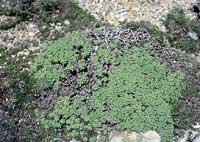
Storksbills (Erodium celtibericum), which still live at the peak of Penyagolosa, seem to have completely disappeared from the Rincón de Ademúz, where there were some instances in the early 1990s, specifically at Cerro Calderón. / Emili Laguna
Shaded nemoral environments and their associated pastures house the last Valencian populations of optimal Alpine, Central European, or Eurosiberian herbaceous species such as Ajuga pyramidalis subsp. meonantha, Arabis alpina or Carex digitata, and the same is true of the streams that pass through them or the springs that flow there, with species like Apium repens, Equisetum hyemale, Athyrium filix-femina, or Parnassia palustris. Some of the rarest orchids in the Valencian region, often present in completely separated areas from other Iberian varieties, such as Coeloglossum viride, Dactylorhiza insularis, Goodyera repens, or Epipactis fageticola, expand the list of endangered plants from these ecosystems (Aguilella et al., 2010).
Despite the fact that they are not included in the sub-Mediterranean vegetation section, the relicts of old Mediterranean laurisilva formations still present in shade forests, which receive humidity from fog retention near the south coast of Valencia and the north of Alicante, seem to be receding. Species such as Spineless Butcher’s Broom (Ruscus hypophyllum) or vegetation types like laurel copses (Laurus nobilis) which are currently considered autochthonous (Costa, 1999), could easily disappear in the future.
High-mountain vegetation
To close the circle of the most endangered vegetation types, perhaps the simplest examples to imagine are the plants from the highest mountain peaks, which will be forced into extinction if their generation-to-generation adaptation rate is too slow compared to the speed of global warming effects. At the moment, the plants that require more atmospheric humidity – for instance, juniper, Juniperus communis subsp. hemisphaerica – are the ones that are experiencing a marked decline in the last few years, while xerophilous species seem to be gaining ground. The reduction in populations of storksbills (Erodium celtibericum), mountain tea (Sideritis pungens subsp. vigoi), or the almost complete disappearance of vitaliana (Vitaliana primuliflora subsp. assoana) are symptoms that cannot be only attributable to an increase in anthropic pressure, but also to a progressive reduction of the environmental humidity conditions that are indicators of these species.
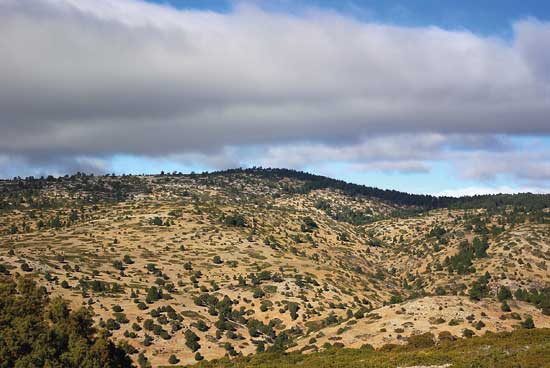
A lovely landscape of the Puebla de San Miguel peaks near Cerro Calderón, dominated by savin juniper (Juniperus sabina). / Emili Laguna
The problem is, of course, also applicable to the high Alicante Mountains, aggravated by the fact that the highest peaks, particularly Aitana, are a separate refuge for Penibaetic high-mountain flora [Penibaetic System is the southernmost of three mountain range systems in the Baetic System, in the southern Iberian Peninsula], especially Sierra Nevada (Laguna et al., 1998). They contain particularly rare or endangered species (Leucanthemum arundanum, Berberis australis subsp. australis, Cotoneaster granatense, or Euphorbia nevadensis susbp. nevadensis), as well as well-preserved species that could become rare in the future (Vella spinosa or Thymus serpylloides subsp. gadorensis). At the same time, the spread of allochthonous ungulates such as Barbary sheep (Ammotragus lervia) contributes to reducing the regeneration capacity of most species in the only environment that currently seems safe from the introduction of invasive exotic plants.
In conclusion
The mentioned examples make the thin line between ecosystem conservation and human action clear; this is particularly true in areas with scarce collective memory, as happens with the harmful effects to coastal ecosystems we learn about every day, or with the overexploitation of surface and underground water sources. Even if negative human action stopped and we tried to restore our rivers and shores to their maximum natural state, many of the abovementioned cases correspond to species that could still disappear because they have already reached the point of no return due to the negative impact and progressive population reduction they have suffered. Some species may be in a similar situation, without human action negatively affecting them, due to their natural rarity, but these are very few compared to the ones whose numbers have decreased because of anthropic reasons.
For now, there is no option for the species that need to migrate to higher altitudes, including some completely endemic Valencian species (for instance, Sideritis pungens subsp. vigoi). Some micro-endemic species from very specific points on the coast may suffer a similar situation: They are susceptible to artificial increases in the number of short- and mid-term populations (like Limonium perplexum), but may be doomed to extinction later if the barriers to the natural retreat of the coastline (roads, etc.) are not removed. Fortunately, most species are not (nor will they be) in a seriously dire situation in the short or medium term, or have safer populations in other locations outside of the Valencia Region. But if we analyse the situation in other territories, we will always find similar problems with other species and plant communities. In the end, the causes listed here are a global problem, and their small-scale effects on plant heritage can be similarly found elsewhere.
References
Aguilella, A., Laguna, E., & Fos, S. (Eds.). (2010). Catálogo valenciano de especies de flora amenazadas. Valencia: Conselleria de Medi Ambient, Aigua, Urbanisme i Habitatge.
Capdevilla-Argüelles, L., Zilletti, B., & Suárez, V. A. (2011). Cambio climático y especies exóticas invasoras en España. Madrid: Ministerio de Medio Ambiente y Medio Rural y Marino.
Costa, M. (1986). La vegetació al País Valencià. Valencia: Universitat de València.
Costa, M. (1999). La vegetación y el paisaje en las tierras valencianas. Madrid: Ed. Rueda.
Costa, M., García-Carrascosa, M., Monzó, F., Peris, J. B., Stübing, G., & Valero, E. (1984). Estado actual de la flora y fauna marinas de la Comunidad Valenciana. Castellón de la Plana: Ajuntament de Castelló.
Domingo, J., Montagud, S., & Sendra, A. (Coord.). (2005). Invertebrados endémicos de la Comunidad Valenciana. València: Conselleria de Territori i Habitatge.
Felicísimo, A. M., Muñoz, J., Villalba, J. C., & Mateo, R. G. (Coords.). (2011). Impactos, vulnerabilidad y adaptación al cambio climático de la biodiversidad española. 1. Flora y vegetación. Madrid: Ministerio de Medio Ambiente y Medio Rural y Marino.
Laguna, E. (2007). La conservació de l'endemoflora valenciana. Mètode, 52, 115–121.
Laguna, E. et al. (1998). Flora endémica, rara y amenazada de la Comunidad Valenciana. València: Conselleria de Medi Ambient.
Moreno-Rodríguez, J. M. (Coord.). (2005). Evaluación preliminar de los impactos en España por efecto del cambio climático. Madrid: Ministerio de Medio Ambiente.
Rosselló, V. M. (1995). Geografia del País Valencià. Valencia: Edicions Alfons el Magnànim–IVEI.
Servei de Vida Silvestre (2013). Trabajos de conservación con la especie en peligro de extinción Silene cambessedesii. Valencia: Conselleria d'Infraestructures, Territori i Medi Ambient. Retrieved from http://www.citma.gva.es/web/biodiversidad/flora
Vizcaíno, A., Collado, F., & Benavent, J. M. (2000). La Devesa de l'Albufera, trenta anys després. Mètode, 26, 38-41.





